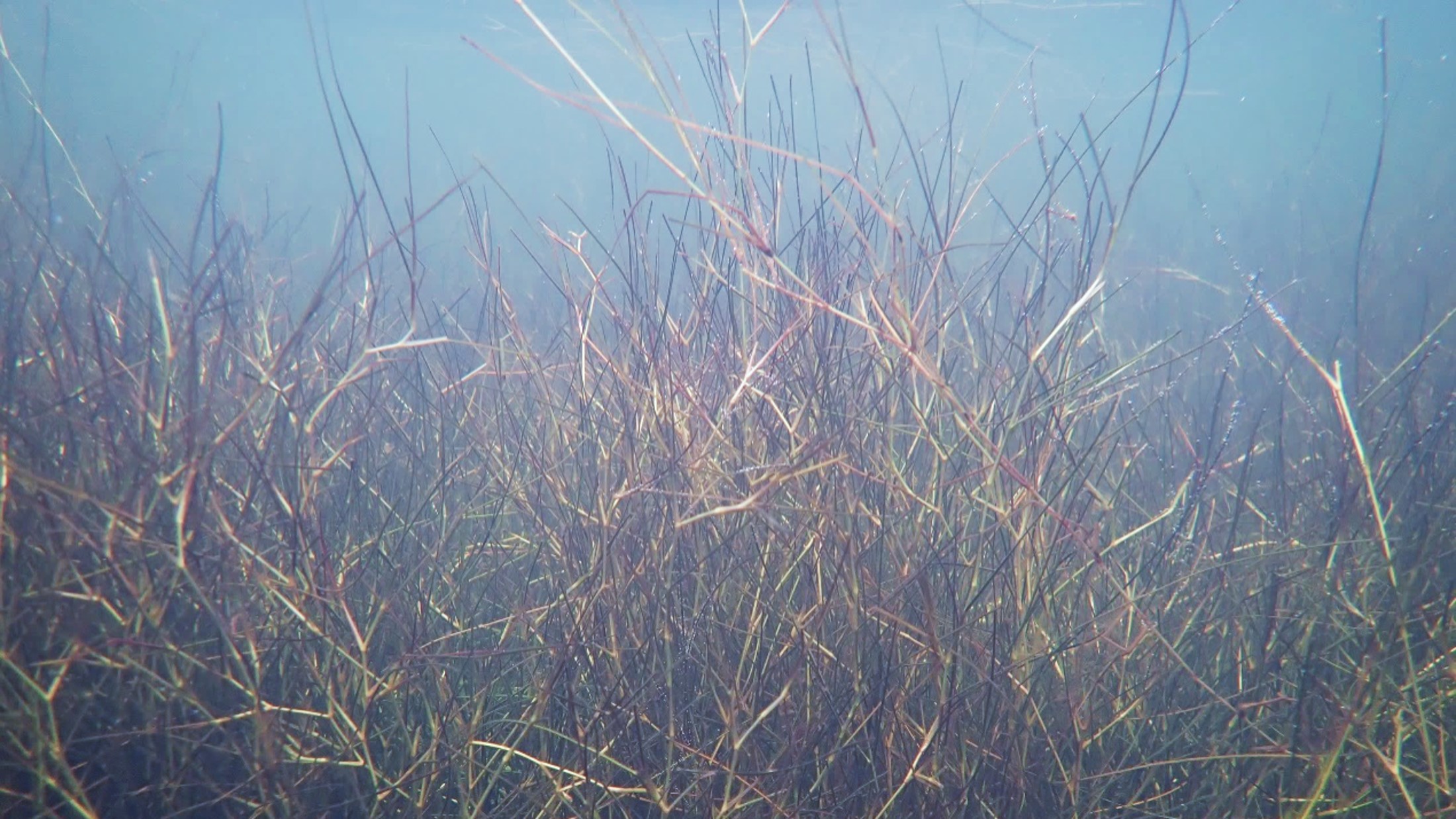The Regional Estuaries Initiative supported the ongoing water quality, seagrass and macroalgae monitoring of the Wilson Inlet since 2016 with monitoring continuing through Healthy Estuaries WA.
Below is the latest data about the condition of Wilson Inlet.
Seagrass meadows are an important part of estuarine ecosystems, providing habitat and food for birds, fish and crustaceans. They contribute to good water and sediment quality by consuming nutrients and oxygenating the water and are estimated to provide $12 million per year in ecosystem services to WA estuaries. Seagrass meadows also store carbon and release oxygen – making them a strong ally in the fight against climate change.
Seagrass condition and distribution throughout an estuary can provide important information about the overall health of the estuary and the quality of water entering it from streams, creeks, rivers and drains.
Ruppia megacarpa is the only species of seagrass found in Wilson Inlet. Seagrass meadows provide food and habitat for animals and produce oxygen, making them an important part of estuary ecosystems. It is important the estuary continues to maintain seagrass meadows and, in turn, healthy ecosystems. However, an overabundance of seagrass has been problematic in previous years, likely due to excessive nutrients in the water (eutrophication).

Ruppia megacarpa
Seagrass distribution in Wilson Inlet
- Excessive nutrients in the estuary led to the extreme growth of seagrass in the 1970s.
- Studies have mapped seagrass in the estuary using various methods, with estimated areas ranging from 1,638 hectares in 1994 to 2,640 hectares in 2007.
- There has been a decline in the extent of seagrass meadows since 2017.
2022-23 monitoring
Seagrass was estimated to cover 1,293 hectares in December 2022, which is about 27 per cent of the estuary area. The seagrass appears to be recovering in some parts of the estuary, particularly in Paynes Bay where seagrass was not recorded in December 2021. Dense meadows were found in several areas of the estuary, including near the mouth of the estuary and at Denmark River, Karri Point and Morley Beach. While the meadows have been dense along Eden Bank in previous years, these were mostly absent in December 2022. Seagrass was found in shallow areas of the estuary, with more than 95 per cent growing in water less than 2 metres deep at the time of the survey.
The average seagrass canopy height was 30 centimetres, but heights of up to 1 metre were observed in some areas.
The abundance of small organisms growing on the seagrass leaves (epiphytes)2 has increased to a medium level since December 2021.
Macroalgae in Wilson Inlet
Macroalgae (or seaweeds) are a vital and natural part of many estuarine and marine ecosystems. They provide important habitat and food for many creatures, and perform essential ecological functions like oxygenating water and absorbing nutrients. However, an overabundance of macroalgae can become a problem, and often indicates too many nutrients in the water. Macroalgae can therefore be indicators of water quality. Assessing macroalgae in estuaries forms part of our integrated understanding of ecosystem health.
In the 1970s, concern rose for the Wilson Inlet following a drastic increase in macroalgae, as well as the seagrass Ruppia. Such increases often indicate eutrophication – a process which occurs when a waterbody is enriched by an oversupply of nutrients, such as nitrogen and phosphorus. This encourages greater plant growth and algal blooms, which can lead to depleted oxygen, as well as occasional foul odours and fish kills. Fortunately, the Wilson Inlet is not currently showing major signs of eutrophication.
There are many different macroalgae species (which should not be confused with seagrasses). These are generally grouped based on their appearance or pigments in their tissue. Various historical studies of macroalgae in Wilson Inlet, as well as recent snapshot surveys by the Department of Water and Environmental Regulation, have identified many species present. Several of these can also grow as epiphytes (organisms that grow on other plants) on the Ruppia leaves and can smother seagrasses if growth becomes excessive.
Some of the macroalgae found in the Wilson Inlet include:
Red algae (Rhodophyta)
- Callithamnion sp
- Ceramium sp
- Chondria sp
- Gracilaria sp
- Laurencia sp
- Polysiphonia sp
Brown algae (Ochrophyta)
- Sirophysalis sp
- Dictyota sp
Green algae (Chlorophyta)
- Acetabularia sp
- Chaetomorpha sp
- Cladophora sp
- Ulva sp
- Lamprothamnium sp (Charophyte)

As part of the department’s seagrass monitoring, snapshot studies occur in Wilson Inlet during survey years. Macroalgae were observed on 27% of occasions in April 2018 and December 2019 (note: areas in the central basin more than 3m deep were not sampled). The cover of macroalgae in these areas was low (about 17.5%) in April 2018 and low to medium (about 37.5%) in December 2019. Both observations were during periods when the sandbar was closed. Macroalgae were less abundant and less dense in December 2017 when the sandbar was open.
The sandbar was open from 24 August 2017 to 25 March 2018 but had closed naturally by the time the April survey occurred. The sandbar was not opened in 2019 due to low water levels.


